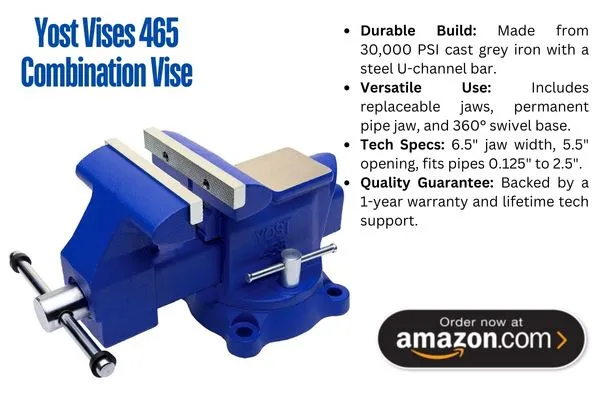If you’re passionate about maintaining an intact lawn, regular mowing is essential to keep it in top condition. However, encountering uneven grass cuts or a brownish tint on your lawn could indicate issues with your mower blades. Such signs typically point to blades that are either chipped, dulled or need sharpening.
I’ll walk you through the simplest ways to sharpen lawn mower blades in this article. You can choose the approach that best fits your resources and preferences. Additionally, we’ll explore whether sharpening the blade is feasible or if replacement is the better option.
How to Sharpen Lawn Mower Blades with a File
To sharpen the lawn mower blades, power tools like grinders are often preferred for this task, but not everyone has access to them. Fortunately, sharpening mower blades using a file is a straightforward and effective alternative and one of my favorite methods. Before you begin sharpening, it’s important to determine whether your mower blade actually needs sharpening. For more detailed guidance on this, refer to the following article here.
So first, let’s get into the step by step process of how to sharpen the blades with a file.
Preparation
Start by removing the mower blades from the mower and ensuring a safe working environment. Gather the necessary tools, a file set with various grits, a wire brush attachment for a drill, a clamp or vice, and safety gear, including eye protection.
You can also grip the blade with your hand, but I would highly suggest having a vise or clamp to avoid any accidents. Check out below if you need one
Blade Sharpening Process With File

- Cleaning: Before sharpening, clean the blades thoroughly to remove any built up debris and crud so you can see the edges of the blade clearly. Use a wire brush attachment on a drill to remove stubborn residue. This step ensures a smoother sharpening process and prevents any debris from interfering with the blade’s edge.

- Selecting the File: Choose a file with an appropriate grit for initial sharpening. A coarse grit file is suitable for removing any nicks or dull edges. Follow up with finer grit files for a smoother finish.
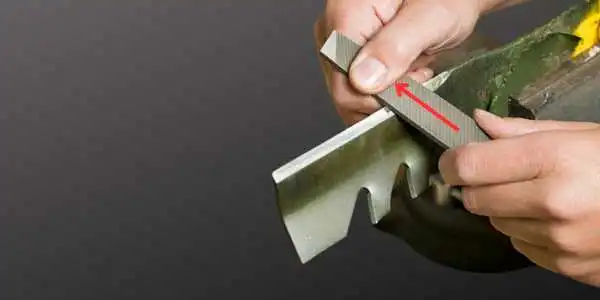
- Filing Technique: Hold the file at a consistent angle against the blade’s cutting edge. I would recommend starting with a higher angle and gradually lowering it to avoid rounding off the blade. Begin filing with steady, even strokes, maintaining the same angle throughout.
- Checking Progress: Periodically stop filing to assess the blade’s sharpness and progress. Take caution not to over file, as this can result in removing too much material and compromising the blade’s integrity.

- Optional Polishing: For those seeking an extra refined edge, an optional polishing step can be performed using Emery wet/dry paper wrapped around the file. This further smooths the blade’s surface and enhances its cutting performance.
How to Sharpen Lawn Mower Blades with a Power Drill
This is the easiest and fastest way to sharpen your lawn mower blade right away, With the added convenience of a plastic guide beneath the stone, maintaining the correct angle becomes effortless. This type of attachment resembles a small grinding stone or wheel, which rotates at high speed when attached to the drill. It efficiently grinds away dull edges on the blade, restoring sharpness with minimal effort.
You can find this sharpener attachment for the drill here
Blade Sharpening Process with Drill

- Secure the Blade: Clamp the mower blade securely in a vise or workbench to prevent movement during sharpening.
- Attach the Sharpener. Fix the blade sharpener attachment to the chuck of the drill machine, ensuring a secure fit.
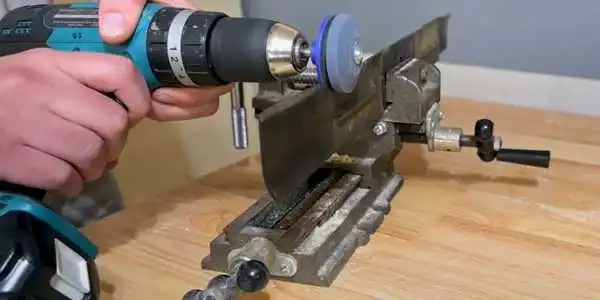
- Guide Placement: Position the plastic guide attached to the sharpener against the beveled edge of the mower blade.
- Safety Gear: Prioritize safety by wearing protective gear, including safety glasses, to shield the eyes from any debris or sparks generated during sharpening.
- Sharpening Technique: With the drill running at a moderate speed, gently guide the sharpener along the length of the blade, applying light pressure to facilitate smooth sharpening. Maintaining consistent pressure and movement is crucial to achieving uniform sharpening results.
Some Reported Problems With Drill Sharpener
- The plastic guide of the drill attachment tends to get hot and makes it challenging to keep the blade steady during sharpening.
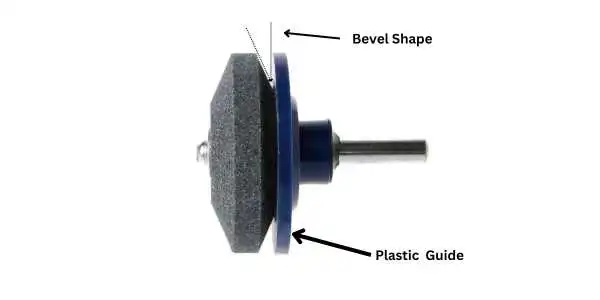
- Some users find that using the side with the plastic guide doesn’t provide the best angle for the bevel, leading to inconsistent sharpening results.
- The plastic components of the attachment may get shredded or damaged over time, affecting its performance and longevity.
- It’s noted that a drill motor may not have enough RPM to achieve the correct speed for the stone sharpener to sharpen effectively.
How to Sharpen Lawn Mower Blades with an Angle Grinder
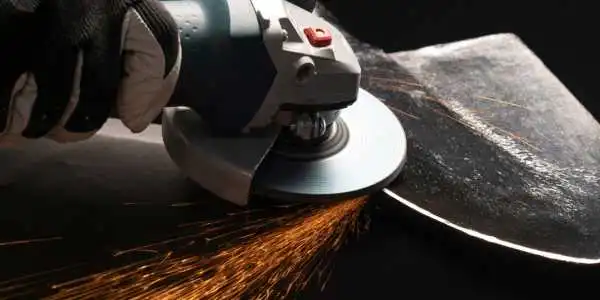
An angle grinder offers a quick and effective method for sharpening mower blades, particularly for tackling noticeable nicks or areas of dullness.
However, using a standard grinding wheel may not be the most ideal choice. From my own experience, I’ve found that it often results in significant material loss. Instead, I recommend opting for an 80 grit flap disc, as it tends to deliver a cleaner finish.
Preparation
- Safety First: Before starting any work, put on safety glasses and hearing protection to shield yourself from sparks and noise generated by the grinder.
- Secure the Blade: Use a vise to secure the blade firmly in place. This prevents movement and ensures safety during sharpening.
- Inspection: Carefully examine the blade for signs of wear, damage, or dullness. Look for nicks, bends, or chips along the cutting edge.
- Cleaning: Remove any dirt, grass clippings, or debris from the blade using a wire brush or a rag. This provides better visibility and prevents contamination during sharpening.
Blade Sharpening Process with Angle Grinder
- Angle Grinder Selection: Use a 4.5-inch angle grinder equipped with an 80 grit flap disc suitable for metal grinding. If you’re without an angle grinder, I highly recommend investing in the impressive DEWALT 20V MAX* Angle Grinder Tool (DCG413B) available at Amazon.
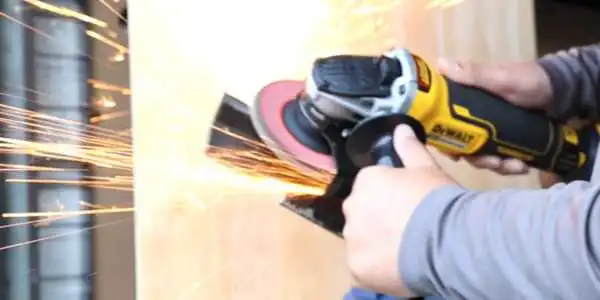
Sharpening Technique
- Setting the Angle: Adjust the angle of the grinder to match the existing angle of the cutting edge. Most lawn mower blades have a beveled cutting edge with a slight angle.
- Light Pressure: Apply light pressure on the grinder to avoid removing too much material. Let the grinder do the work, and move it steadily along the cutting edge.
- Follow the Contour: Maintain the original contour of the blade while sharpening. Avoid grinding unevenly, as this can lead to an imbalanced blade.
- Consistency is Key: Ensure consistent sharpening across the entire length of the blade. Pay extra attention to areas with visible nicks or damage.
Deburring
- Removing Burrs: After sharpening, inspect the backside of the blade for any burrs or rough edges. These can affect cutting performance and should be removed.
- Using a File: Use a file to gently remove burrs by running it along the backside of the cutting edge. This step ensures a smooth and sharp cutting surface.
Maintaining the correct angle can be challenging, and when using a grinder, achieving the precise angle of sharpness can be tricky due to limited visibility. It often feels like a guessing game.
Furthermore, applying excessive pressure by mistake can result in the removal of excess material from the blade, ultimately affecting its lifespan.
How to Sharpen Lawn Mower Blades with a Bench Grinder

Undoubtedly, using a bench grinder is one of the quickest methods for sharpening blades. Many professional blade sharpening services rely on bench grinders for their ability to achieve precise and controlled sharpening results.
Sharpening with a bench grinder demands a certain level of skill, as improper technique can potentially damage the blade. So when using the bench grinder, stay focused. Now, let’s look at a step by step sharpening process.
If you want to invest or upgrade your sharpening game, I would suggest buying DEWALT Bench Grinder, 6 Inch, 3/4 HP, 3,600 RPM
Setup Bench Grinder:
- Setting Up: Position the bench grinder on a stable surface and secure it in place.
- Installing the Wheel: Install the appropriate grinding wheel for sharpening metal blades. A medium grit silicon carbide or aluminum oxide grinding wheel works best. For this use, a wheel with grit levels between 80 and 120 would be appropriate.
- Adjustments: Adjust the tool rest to the desired angle for sharpening the blade, preferably at 30 degrees.

Blade Sharpening Process using Bench Grinder
- Hold the blade securely against the tool rest, ensuring it’s positioned at the correct angle for sharpening.
- Turn on the bench grinder and gently bring the blade into contact with the grinding wheel.
- Move the blade back and forth across the grinding wheel, applying light pressure to remove material evenly.
- Pay attention to maintaining a consistent angle and pressure throughout the sharpening process.
- Periodically check the blade for sharpness and adjust the sharpening angle or pressure as needed. I believe you have to check the sharpness of the blade after 4 or 5 passes.
- Continue sharpening until the cutting edge of the blade is uniformly sharp and free of nicks or dull spots.
Tip: Before starting to sharpen the lawn mower blade, true the grinder wheel first. You can use a diamond dressing tool. Turn on the grinder, then bring the spinning wheel into contact with the diamond tool to flatten and smooth its surface. This ensures precise grinding, which is essential for sharpening mower blades effectively.
Check the Blade’s Balance
After sharpening the mower blade, it’s essential to check its balance to ensure smooth and efficient operation. You can find blade balancers at a very cheap price on amazon.
Here’s how to do it:
- Hang Test: Hang the sharpened blade on a nail or screwdriver through the center hole.
- Observation: Observe how the blade hangs. It should remain level without tilting to one side or the other.
- Adjustment: If one side of the blade dips lower than the other, remove material from the heavier side using a file or grinder until it hangs level.
- Recheck Balance: After making adjustments, retest the blade’s balance until it hangs evenly.
Is it Better to Sharpen or Replace the Mower Blade?
When it comes to replacing or sharpening, it depends on the condition of the blade.
Blade Sharpening
Sharpening is suitable for blades with minor dullness or small nicks. It’s a cost effective way to extend the life of the blade and maintain cutting performance. As I mentioned, the most economical way is to use a drill sharpening attachment or a filing method.
Blade Replacement
If a blade is severely damaged, bent, or excessively worn, then it would be time wasting to sharpen this blade, replacement may be necessary. A well sharpened blade is essential for achieving clean, even cuts and preventing damage to the grass.
The cost of purchasing a new mower blade can vary depending on factors such as brand, blade type, and size. However, you can typically expect to pay anywhere from $20 to $60 for a new blade, with prices varying based on quality and materials.
If you’re unsure which mower blades are best for you, take a look at this detailed article on “Choosing the Right Lawn Mower Blades”
Conclusion
Maintaining a well groomed lawn requires attention to detail, especially when it comes to sharpening mower blades. Whether you go for the traditional file method, the convenience of a power drill, or the efficiency of an angle grinder, each technique has its merits and considerations. But here’s the question for you: What’s your preferred method for sharpening mower blades? comment below


